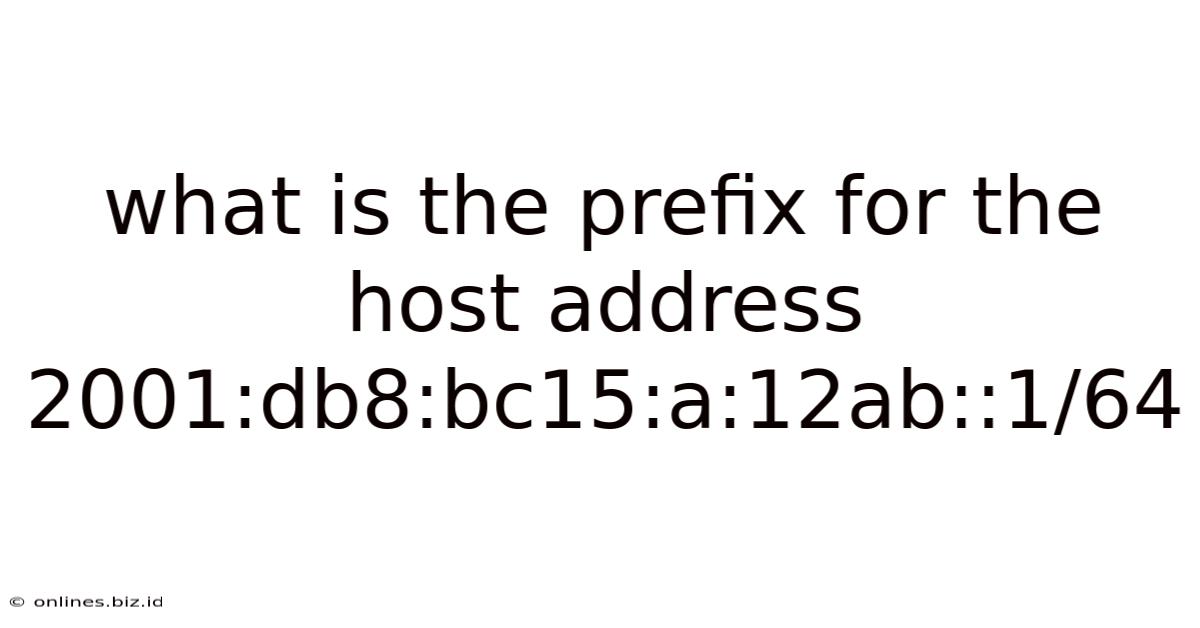What Is The Prefix For The Host Address 2001:db8:bc15:a:12ab::1/64
Onlines
May 09, 2025 · 4 min read

Table of Contents
What is the Prefix for the Host Address 2001:db8:bc15:a:12ab::1/64? Understanding IPv6 Addressing
The internet's explosive growth necessitates a robust and scalable addressing system. IPv4, while functional for a time, has reached its limitations. IPv6, its successor, offers a vastly expanded address space and improved features. Understanding IPv6 addresses, including prefixes, is crucial for network administrators and anyone working with internet infrastructure. This comprehensive guide delves into the specifics of the IPv6 address 2001:db8:bc15:a:12ab::1/64 and explains how to determine its prefix.
Deconstructing IPv6 Addresses: A Primer
Before we pinpoint the prefix of our target address, let's review the fundamentals of IPv6 addressing. An IPv6 address is a 128-bit number, typically represented in hexadecimal notation. This notation uses eight groups of four hexadecimal digits, separated by colons. For example: 2001:0db8:85a3:0000:0000:8a2e:0370:7334.
To simplify representation, leading zeros within a group can be omitted, and consecutive groups of zeros can be compressed to a single ::. Our example could be shortened to 2001:db8:85a3::8a2e:370:7334. Remember, the :: can only appear once in an address.
Understanding IPv6 Prefixes (/64 Notation)
The /64 notation you see appended to our target address (2001:db8:bc15:a:12ab::1/64) signifies the prefix length. This indicates the number of leading bits that represent the network portion of the address. In this case, the /64 means the first 64 bits define the network prefix, while the remaining 64 bits specify the host address within that network.
What does this mean practically? The prefix uniquely identifies a specific subnet or network segment. All devices within that subnet share the same prefix. The remaining portion of the address, the host identifier, uniquely identifies each individual device within that subnet.
Determining the Prefix of 2001:db8:bc15:a:12ab::1/64
Now, let's focus on our address: 2001:db8:bc15:a:12ab::1/64. The /64 explicitly tells us the prefix length. Therefore, the prefix is the first 64 bits of the address.
To visually represent this:
2001:db8:bc15:a:12ab::1/64
^^^^^^ ^^^^ ^^^^ ^ ^^^^^ ^^^^ ^^^^^^
| | | | | | |
+-------+-----+---+------+------+-------+-----> Prefix (64 bits)
|
+-----> Host Identifier (64 bits)
Therefore, the prefix for the host address 2001:db8:bc15:a:12ab::1/64 is 2001:db8:bc15:a:12ab::.
The Significance of the Prefix Length
The prefix length is a critical component of IPv6 addressing. It determines the size and scope of the network. Different prefix lengths are used for various purposes:
/64(Most Common): This is the standard prefix length assigned to individual end-user networks (e.g., home networks, small offices). It provides a vast number of available host addresses./48: Commonly used for global unicast addresses and provider-based allocation. It allows for a hierarchical structure.- Larger Prefixes (
/32,/24, etc.): Used for larger network segments and backbone infrastructure. They represent broader network ranges. - Smaller Prefixes (
/65,/66, etc.): Used for subnetting within a/64network, allowing further division of resources.
Practical Applications and Considerations
Understanding IPv6 prefixes is crucial for several networking tasks:
- Network Configuration: Correctly configuring routers, firewalls, and other network devices requires knowing the network prefix to manage routing tables and access control lists effectively.
- Subnet Planning: When designing a network, careful consideration of the prefix length ensures sufficient host addresses while optimizing network efficiency.
- Troubleshooting: Diagnosing network connectivity issues often involves analyzing IPv6 addresses and prefixes to identify misconfigurations or routing problems.
- Security: Firewall rules and security policies often rely on prefix-based filtering to control network access and prevent unauthorized connections.
- Network Address Translation (NAT): While less common in IPv6 due to the massive address space, understanding prefixes is still relevant for situations where NAT might be implemented.
IPv6 Address Allocation and Routing
IPv6 addresses are allocated hierarchically. Internet service providers (ISPs) receive larger prefixes from regional internet registries (RIRs), which then further subdivide them for assignment to their customers. This hierarchical structure ensures efficient routing and address management across the global internet.
Tools and Resources for IPv6 Address Analysis
Various online tools can help in analyzing IPv6 addresses and prefixes. These tools can often provide detailed information about the address, its prefix, and its location. Knowing how to utilize these tools is beneficial for network administrators and anyone working with IPv6 networks.
Conclusion: Mastering IPv6 Prefixes
The prefix of an IPv6 address, as demonstrated with the example 2001:db8:bc15:a:12ab::1/64, plays a critical role in network management, address allocation, and security. Understanding the concept of prefix lengths and their implications is crucial for anyone involved in networking, whether in a home network setting or a large-scale enterprise environment. By mastering IPv6 addressing and prefix notation, network professionals can ensure efficient, secure, and scalable internet connectivity in today's digital world. With the increasing adoption of IPv6, this understanding is becoming increasingly vital.
Latest Posts
Latest Posts
-
New Drivers Can Usually Develop Good Habits Quickly
May 09, 2025
-
Which Of The Following Is Not A Myth
May 09, 2025
-
2 7 Composition Of Functions Practice Set 1
May 09, 2025
-
A Pendulum Consists Of A Small Object
May 09, 2025
-
Establishing The Maximum Select Quotas For The Active Component
May 09, 2025
Related Post
Thank you for visiting our website which covers about What Is The Prefix For The Host Address 2001:db8:bc15:a:12ab::1/64 . We hope the information provided has been useful to you. Feel free to contact us if you have any questions or need further assistance. See you next time and don't miss to bookmark.